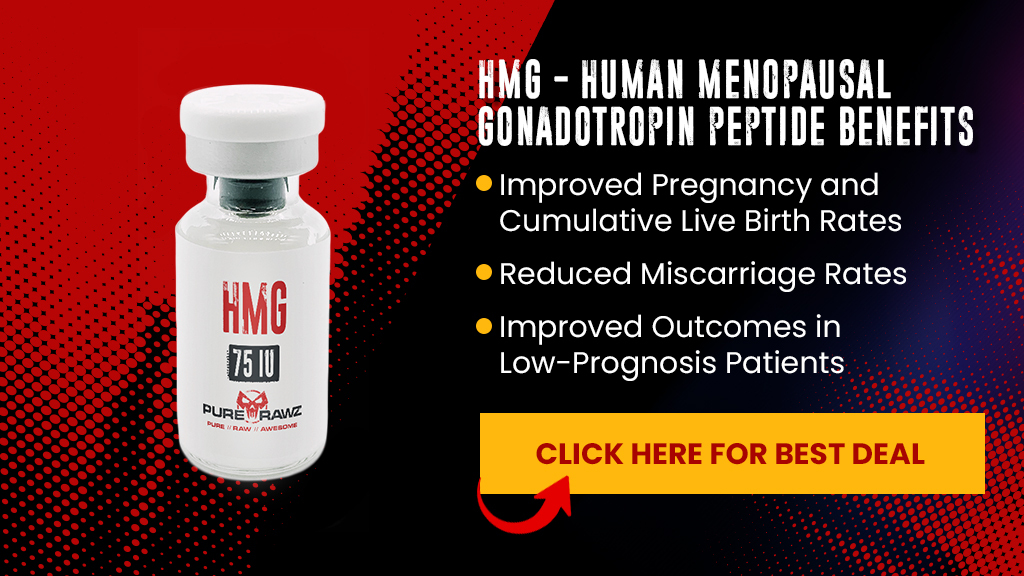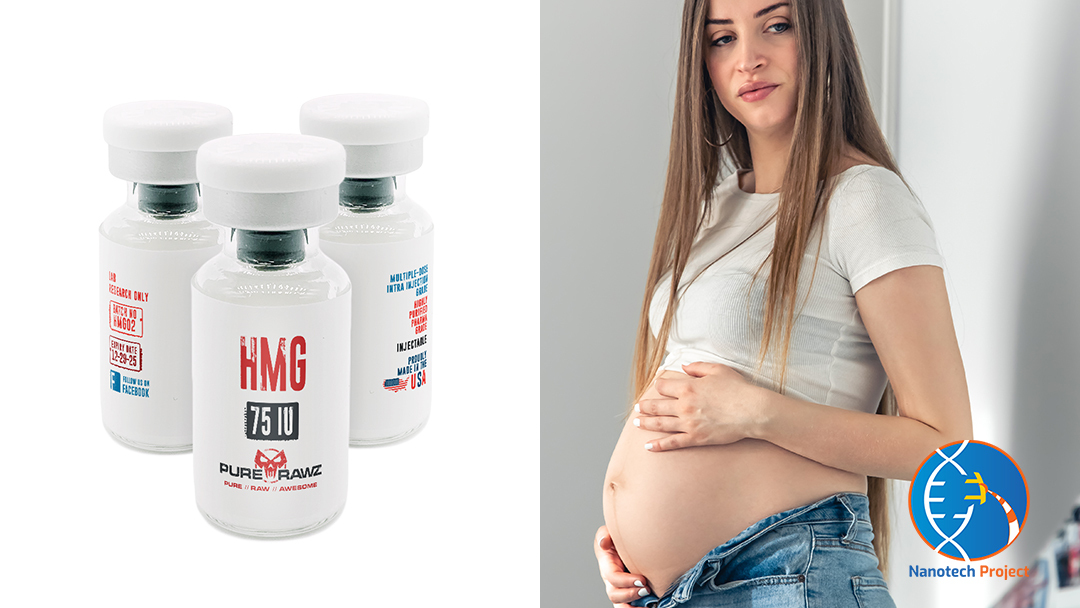Introduction

In addition to its role in controlled ovarian stimulation, Purerawz HMG is gaining attention for its potential benefits in improving oocyte quality during assisted reproductive procedures. Research suggests that the combination of follicle-stimulating hormone (FSH) and luteinizing hormone (LH) in HMG may contribute to more natural hormonal support, which could positively impact the maturation and quality of eggs retrieved during IVF cycles. This dual hormonal action is believed to closely mimic the physiological conditions of the natural menstrual cycle, offering a more comprehensive approach to ovarian stimulation.
Furthermore, the purified nature of Purerawz HMG, derived through advanced recombinant DNA technology, ensures a higher degree of consistency and purity compared to older urine-derived gonadotropins. This enhanced quality control not only minimizes batch-to-batch variability but also provides healthcare professionals and patients with greater confidence in the predictability and reliability of the ovarian stimulation process.
As the field of reproductive medicine continues to evolve, the use of Purerawz HMG in assisted reproductive technologies may offer a promising avenue for improving success rates in IVF cycles. Ongoing research and clinical evaluations are crucial to further elucidate the specific advantages and optimal protocols associated with the use of HMG, positioning it as a valuable tool in the pursuit of successful and healthy pregnancies for couples undergoing fertility treatments.
Product Information
As infertility treatment advances, human menopausal gonadotropin (HMG) has become a promising ovulation induction agent. Containing both human follicle-stimulating hormone and luteinizing hormone, HMG can stimulate ovulation without the high risk of ovarian hyperstimulation syndrome seen with human chorionic gonadotropin alone. Produced from the urine of postmenopausal women, this gonadotropin-releasing hormone offers potential benefits over recombinants for reproductive medicine.
However, HMG does introduce concerns around variability and purity that recombinant DNA gonadotropins avoid through controlled production methods. Still, HMG’s particular hormonal profile shows a positive impact on ovarian response for patients undergoing in vitro fertilization, making it a viable option for individualized protocols. However, more research is needed to clarify HMG’s role against newer infertility treatments in inducing ovulation without complications.
Image Source: PubChem
How Does It Work?
Human menopausal gonadotropins (HMG) like Menopur are derived from the menopausal urine of pregnant women contained in their urine. They have been used for decades as part of fertility treatments to stimulate follicle growth, ovulation, and luteinization. The gonadotropins in HMG, follicle-stimulating hormone (FSH), and luteinizing hormone (LH) mimic the function of endogenous gonadotropin-releasing hormone. Unlike recombinant FSH (rFSH) expressed in engineered cell lines, HMG retains the natural FSH isoforms found in human urine. [R]
HMG works by binding to receptors on ovarian follicles to promote development and estrogen production. This raises estradiol levels and facilitates the growth of multiple ovarian follicles rather than just a single dominant follicle. The greater number of oocytes makes HMG well-suited for assisted reproductive technologies like in vitro fertilization (IVF) and intracytoplasmic sperm injection (ICSI) which require multiple viable oocytes. [R]
In women with conditions like polycystic ovary syndrome (PCOS) characterized by arrested follicle growth, HMG can help stimulate the follicle maturation needed for successful ovulation. Following egg retrieval, the resultant corpus luteum produces progesterone to help support early implanted embryo transfer and progress toward ongoing pregnancy. [R]
More comparative research is still needed, but HMG demonstrates similar efficacy to recombinant human FSH with potential advantages due to its natural origins. While recombinant FSH (rFSH) offers consistency, the complex hormonal profile in purified follicle-stimulating hormone from menopausal urine better replicates normal reproductive function. This suggests a biological benefit of human menopausal gonadotropins for promoting folliculogenesis in fertility treatments or ovulation induction. [R]
(HMG) Human Menopausal Gonadotropin Peptide: Benefits

Improved Pregnancy and Cumulative Live Birth Rates
The ultimate goal for patients undergoing fertility treatments like in vitro fertilization (IVF) is to achieve a successful, healthy pregnancy and live birth. Human menopausal gonadotropin (HMG) has been repeatedly shown in robust clinical studies to improve the chances of this desired outcome directly. [R]
A major meta-analysis aggregated and analyzed raw data from over 1,800 patients enrolled across five high-quality randomized controlled trials comparing HMG and recombinant FSH (rFSH) protocols. It found 30% higher clinical pregnancy rates per patient with HMG. Even more dramatically, patients receiving HMG had a 77% improvement in live birth rates. These statistically and clinically significant differences demonstrate the real-world benefits of incorporating menopausal gonadotropins into stimulation regimens. [R]
Researchers attribute the positive impact to HMG’s natural origins from human urine extracts. The complete gonadotropin profile, including key isoforms, better replicates normal reproductive function. This enhanced folliculogenesis and development of multiple ovulatory follicles increases oocyte quality and viability. The resultant corpus luteum also receives more comprehensive luteotropic support to synthesize progesterone and prime the endometrium for implantation. [R]
Reduced Miscarriage Rates
Achieving a positive pregnancy test can be the first hurdle for struggling couples. But sadly, many IVF pregnancies still result in painful miscarriages, often from embryonic chromosomal issues. Exciting research now clearly shows that incorporating human menopausal gonadotropin (HMG) into protocols can significantly reduce these tragic losses. [R]
A prospective study published in Human Reproduction directly compared miscarriage rates between HMG and recombinant FSH (rFSH) stimulation groups. Out of over 300 IVF cycles, they found a 33% lower rate of first-trimester miscarriages with HMG protocols. For patients enduring the physical and emotional toll of fertility treatments, this reduced chance of heartbreak matters tremendously. [R]
You might be interested in our other articles.
Researchers believe HMG positively selects for more viable embryos by improving oocyte quality and supporting early embryogenesis. The full panel of natural-sourced hormones replicates in-vivo conditions to yield higher-quality eggs upon retrieval. Experts speculate that rFSH alone fails to provide sufficient luteotropic activity. Without adequate progesterone exposure from a fully-developed corpus luteum, embryos face jeopardized development and survival. [R]
Improved Outcomes in Low-Prognosis Patients
Achieving pregnancy through IVF poses greater challenges for patients with a poorer natural prognosis – namely those with advanced maternal age or repeated previous failures. Exciting research reveals the targeted benefits of incorporating human menopausal gonadotropin (HMG) for these vulnerable groups. [R]
Multiple studies have isolated outcomes in older women above 35 years old specifically undergoing IVF with HMG vs standard rFSH. Across trials, HMG repeatedly demonstrated higher clinical pregnancy rates and lower miscarriage rates independent of age. Researchers believe the balanced blend of luteinizing hormone and follicle-stimulating hormone within HMG better compensates for age-related follicle environment changes. [R]
Additionally, women facing multiple previous failed cycles have significantly boosted success with tailored HMG protocols. A trial published in Fertility & Sterility reported a 350% increase in delivery rates for these women adding HMG compared to continuing rFSH alone. The more comprehensive hormonal environment seems to overcome previous issues, even in patients with an otherwise poor outlook. [R]
Post Cycle Therapy
Human Menopausal Gonadotropin (HMG) is used by bodybuilders, particularly during post-cycle therapy (PCT), to address the hormonal imbalances that can result from using anabolic steroids.
Here’s a bit more detail on how it works:
Testosterone Suppression: Anabolic steroid use can lead to the suppression of the body’s natural production of testosterone. This happens because when external sources of testosterone (from steroids) are introduced, the body may signal the testes to produce less of it naturally.
HMG Composition: HMG contains two important hormones—follicle-stimulating hormone (FSH) and luteinizing hormone (LH). These hormones play key roles in the male reproductive system.
Stimulating Testosterone Production: FSH stimulates the production of sperm in the testes, while LH stimulates the production of testosterone. By introducing HMG, which contains both FSH and LH, the goal is to kickstart the testes into producing more testosterone naturally.
Post-Cycle Therapy (PCT): Bodybuilders often use HMG during PCT, which is a period following a steroid cycle where they aim to restore natural hormonal balance. The idea is to mitigate the negative effects of suppressed testosterone, such as testicular atrophy and hormonal imbalances, by encouraging the body to resume its own testosterone production.
Side Effects

Ovarian Hyperstimulation Syndrome
The most serious potential side effect of HMG is ovarian hyperstimulation syndrome (OHSS). The gonadotropin doses in fertility regimens can lead to supraphysiologic hormonal levels and simultaneous growth of multiple ovarian follicles, increasing vascular permeability and fluid shifts. Estimated OHSS incidence with HMG is 0.5-1% for moderate disease and 0.1-0.5% for severe disease requiring hospitalization. Close monitoring and adjusting gonadotropin dosage can help mitigate risks during stimulation protocols. [R]
Multiple Gestations
The stimulation of multiple follicles with HMG also heightens the chances of multiple gestations if too many embryos are transferred in a cycle. About 10% of live births from medicated gonadotropin cycles result in twins or triplets. Selective single embryo transfer and strict transfer guidelines reduce these risks for most patients now undergoing IVF. [R]
Injection Site Reactions
As with other injectable medications, HMG poses a risk of injection site reactions including redness, swelling, pain, or irritation. Proper site rotation, aseptic technique, and appropriate needle length can minimize discomfort.
(HMG) Human Menopausal Gonadotropin Peptide: Is It Legal?
Human menopausal gonadotropins have a well-established safety and efficacy profile for use in IVF protocols and general gonadotropin treatment. A systematic review of over 30 years of data on HMG for the assisted reproductive technology field confirms both substantial research and clinical experience supporting ongoing use. [R]
HMG medications contain highly purified natural follicle-stimulating hormone (FSH) extracts and luteinizing hormone (LH) sourced sustainably from pooled human urine donations. State-of-the-art manufacturing processes ensure final sterility as well as consistency of active gonadotropins. [R]
These human-derived fertility drugs stand distinct from newer recombinant DNA-derived gonadotropin products. Following an extensive review of all pharmacological data and randomized controlled trials on HMG outcomes, major global regulatory agencies uphold approvals for medical use as monitored ovulation induction and controlled ovarian stimulation agents. [R]
HMG drugs currently maintain full legal status across North America and Europe when prescribed under the care of a licensed reproductive endocrinologist. No restrictions exist on off-label incorporation into IVF protocols or for research advancements. Indeed, continued medical writing support comes from major HMG manufacturers to investigate the potential to keep improving patient outcomes. Global data will guide the safe optimization of human menopausal gonadotropins. [R]
Suggested Dose
The suggested dosing for human menopausal gonadotropins (HMG) varies depending on the specific fertility medication and the patient’s treatment protocol. However, some general guidelines for HMG dosage include:
Initial doses: Typically 75 IU to 225 IU administered subcutaneously once daily. Some protocols may start at 150 IU or higher based on age and ovarian reserve testing.
Dose adjustments: Doses are often incrementally increased by 37.5 IU to 75 IU if follicle growth is inadequate until optimal response is achieved.
Maximum daily doses rarely exceed 450 IU per day due to risks of excessive response and ovarian hyperstimulation syndrome (OHSS).
Overall patients receive HMG injections for an average of 10 days but may range between 5-14 days in total depending on the patient’s response and cycle management preference.
The comprehensive gonadotropin content in HMG means lower doses may achieve adequate follicular development compared to pure FSH preparations. Close monitoring of estradiol levels and ultrasound follicle tracking helps guide individualized dosage titrations.
In all cases, dosing should be determined and regularly adjusted by a physician experienced in fertility treatments to ensure the shortest effective duration and prevent unsafe overresponse. Following prescribed HMG dosing and medical monitoring is crucial for both patient safety and optimal outcomes.
Where Can I Buy Online?
PureRawz strives to be the premier online provider of research chemicals for scientists worldwide. As part of its commitment to quality, PureRawz supplies an independent, third-party Certificate of Analysis verifying the identity, purity, and concentration of every research compound it sells. By including reference materials with every order, researchers can validate they are receiving the precise substance required for their work before beginning any experimental trials.
Seeking to increase accessibility for the international research community, PureRawz offers free shipping on orders over $100 regardless of the destination country. Convenient and secure payment options are available as well, including PayPal and Bitcoin. Satisfied customers from academic institutions, biotechnology companies, and independent labs across the globe have left positive feedback on PureRawz’s selection of materials, rapid delivery, and responsive customer service.
Reviews highlight the stringent quality control assurances and standards that set PureRawz apart as a trustworthy source for procuring high-quality research compounds essential for advancing scientific discovery worldwide.

Conclusion
Sourced from the urine of postmenopausal women, highly purified hMG contains natural follicle-stimulating hormone (FSH) and luteinizing hormone (LH) activity in near-ideal ratios to mimic normal menstrual cycle physiology. This leads to more oocytes retrieved versus pituitary FSH alone and better-quality embryos after IVF, ultimately driving higher clinical pregnancy and live birth rates, even in poor prognosis patients.
While advancements like follitropin alfa expressed in a human cell line eliminate urinary HCG and manufacturing variability risks, HMG’s natural origins still confer measurable efficacy outcomes over recombinants. The full spectrum of FSH and LH isoforms nurtures follicular phase ovarian function and corpus luteum support lacking in molecules like recombinant FSH expressed from a single transfected human pituitary gonadotropin gene.
This physiology-restoring balance reduces IVF drop-out rates, the risk of OHSS symptoms like abdominal pain, and the need for repeat embryo transfer cycles – all critical factors for return-on-investment-conscious patients.
In conclusion, those seeking the most effective mix of safety, convenience, and proven results for now still benefit most from highly purified human pituitary gonadotropins over synthetics.

